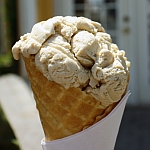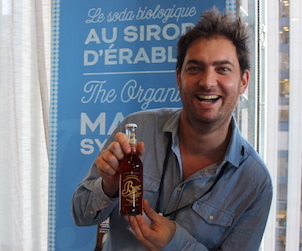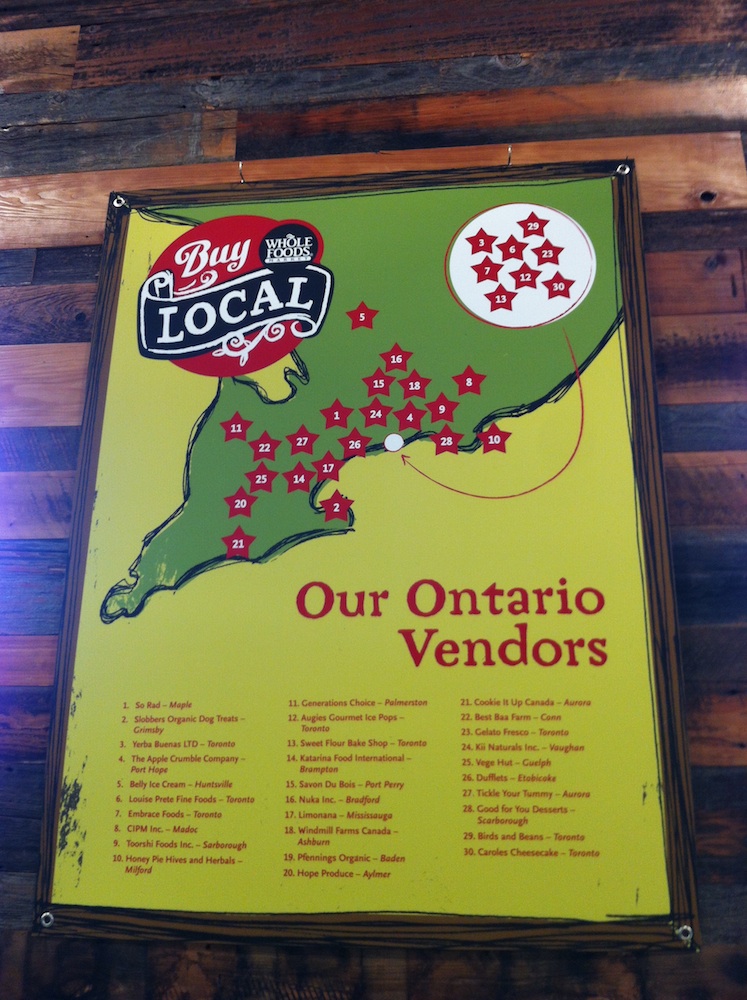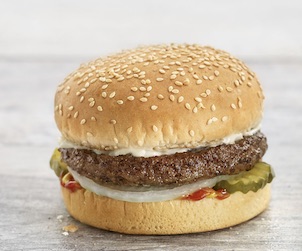by Emily Materick
[This article is the sixth in a series on artisanal ice cream makers, to see all of Emily Materick’s ‘Scoops’, click here – Ed.]
This week I’m taking The Scoop on a well deserved summer mini break to the tiny town of Bloomfield and the excellent Slickers ice cream shop. A truly seasonal business, the bright yellow shop is a simple triangle – a screen door in, a screen door out and room enough between for you, a friendly scooper and a glass counter filled with interesting choices.
I meet the enigmatic owners, Marie Frye and Pat Hacker, outside on a lawn sprinkled with bright Muskoka chairs and a couple picnic tables. After receiving warm welcomes and firm handshakes, I take a spot with them in the sun to discuss their labour of love. Throughout our conversation, a constant stream of families flows through the shop, locals stop to say hello and a farmer on a tractor drives by, shouting out a good review to the gathered crowd of tourists. “We pay him to do that” Marie jokes. Both women are incredibly passionate about their product and using the area that they live in to the fullest. In a business that only lasts a few months a year, Slickers is careful to pack every ounce of flavour their ingredients can provide into each and every scoop.
E: How did you both get started making ice cream?
M: Take it away, Pat..
P: I was about to say, take it away, Marie! Well, we moved here in about 1989. We bought property here and looked around to see what’s not here that needs to be. At that time, we were both enjoying Greg’s ice cream. We thought a premium ice cream! What goes better with summer and the beach and all that? We approached Greg and asked if he would make ice cream for us, which he said he would do. The provision was, of course, that we pick it up when it’s ready because he didn’t have room in his coolers. We said ok and we began to bring products, local products for him to put into the ice cream. That meant we were taking two trips – one to bring the products and one to pick up the ice cream.
M: Because we’re in an agriculturally based area too and we lived in Bloomfield. Bloomfield used to be the old canning factory town. Well, the county had many canning factories but Bloomfield was the last village to have any so it took in all the corn and squash and vegetables and everything and canned for everybody.
P: Our production facility is located in the last of the old canning factories.
M: But, we did. We took locally grown strawberries and raspberries and home baked pies to him to put in the cream and then we would bring it back then we could pitch it as local ingredients. Then our car died on the 401. We lost a lot of ice cream. It made sense, a certain kind of sense. So I went off to Guelph and took the ice cream technology course and learned more than you’d ever want to know about milk and bacteria.
So, we decided that it was probably time. We seemed to have tested the market for the first few years, basically, with would people really make the stretch and pay more? Would cost conscious rural customers do it? Not that the city wouldn’t. We knew the city (customers) would. We were part of that city population that wanted something better. We thought this would be a good marriage, if you will, between the rural based economy and tourism, which with Sandbanks and the county had not yet developed into a viticultural area as well. Tourism was really about Sandbanks and the beach. We had a bed and breakfast and Pat had retired from the National Film Board and I had retired from my job – not retired, quit. So we thought that was probably worthwhile.
E: Had you tried making ice cream at home before you started the business?
M: Pat had.
P: No, I grew up making ice cream in the summertime, my mother made ice cream and that was a part of summer life. I remember to this moment the taste of that ice cream. My favorite flavour was peach and we do not make peach! No, we can’t get a rich enough peach flavour unless we use an artificial flavour.
M: Pat grew up in North Carolina in the summer, so her version of peach ice cream was the Georgia peach not Niagara peaches.
P: Yes, peaches and cream – just amazing, amazing, amazing! I, to this day, long for that peach ice cream. So, we don’t make what we can’t make right. If it doesn’t have the right flavour or we have to use something artificial – no.
E: What do you find to be the benefits of being a small batch ice cream producer?
M: We can only eat so much! [Laughs]
E: [Laughs] is that a benefit or is that a challenge?
P: Well, we can’t make a lot so we can’t eat…We only eat what we don’t sell! The benefit of being small is that we’re hands on, is that we can do the one-offs, you know…
M: You want garlic ice cream, you want corn ice cream for your family barbeque – we’re your girls.
E: That’s so great. Have you made a garlic ice cream?
P: Of course! Many times and also a corn ice cream.
M: We did a Red Russian for the garlic festival in Perth.
P: It’s a variety of garlic.
M: So, we did a Red Russian garlic that I did last week and we also a red onion marmalade.
E: Just shot through it?
M: Yeah, running through it.
P: We also, when our herb season comes, we have basil, mint of course.
M: We did a combination rhubarb and lavender.
P: Yes, rhubarb and lavender – very nice.
M: For the lavender farm we did five different varieties of lavender ice cream.
P: You know, the lavender farmer comes and lays down her blossoms and says how different each one is in colour and such so you really have to somehow create, both in her mind and in the product, the recognition of the differences in the lavender.
E: Were the differences very subtle?
P: Very subtle.
E: Did you take other flavours to try to pair with the lavender or just make the ice cream pure?
M: For what she wanted, she was fairly clear on what she wanted so we just did what she wanted, just pure flavour.
P: I was swimming with a woman who said she made rhubarb and lavender jam, so I thought if you can make rhubarb and lavender jam, we can make rhubarb lavender ice cream.
E: So, then, what are the challenges you’ve found by being small?
P: Making money!
M: Not eating all the product! Let’s see, what other challenges…
P: Dealing with OMAFRA (Ontario Ministry of Agriculture, Food and Rural Affairs).
M: Yeah, we didn’t realize when we separated our production from our retail that we had to become a dairy. Talk about jumping through hoops! If you want to distribute then you had to become a dairy.
P: And if you are an artisan ice cream producer and you have to conform to the standards that apply to Reid’s Dairy, Kawartha Dairy, Sealtest – its craziness! And when they come and tell you that your ceiling is one inch too low – too low for what? Well, too low for the pasteurizing machine. Sorry, we don’t have any, we use a pasteurized product – it doesn’t matter. It doesn’t matter – you’re a dairy, you have to have the ceiling one inch higher.
E: It seems bizarre that they use those regulations for people who are not producing milk on the premises.
P: We have never objected to any other ice cream companies for the simple reason that we make what we make and we sell what we sell. We don’t do what other people do. We also don’t make kids flavours – Ropy Tiger Tail – there might be anisette. I think kids need to learn what good ice cream is therefore they should have good product.
M: It’s kind of about educating your consumer too. You talk to people and then people say “Oh my god, you have a Peruvian whatever whatever” and then all of sudden they get a hint of the possibilities.
E: We have this reaction with a lot of the fruit flavours at Xococava, people try them and say, for instance “this tastes so much like mango” They just can’t believe it. You have to say, well, it is mango. That’s what real mango tastes like. It makes a difference having non-artificial flavours, people aren’t used to that.
P: I think we love doing what we do. It’s a treat. It’s become so much bigger that we do no have as much hands on in here for a variety of reasons. We’re tired; there are other things for us to do. The rhythm of young people – they move back and forth with each other. When I go in and plant myself there, I’m an obstacle as would be Marie. They work at their rhythms. I play with the customers when I’m in there. Another thing, I don’t know if you’ve experienced, but people become four year olds, very large four year olds. The older ones tend to open their mouths when you hand them a sample – just shovel it in! [Laughs.]
M: I refuse to do that. Grab it yourselves! [Laughs.]
P: It’s that thing that you really see how people regress to the earliest choices they made and become very serious. Shall I have two different flavours, which one on the bottom, ooh! When someone says whatever, I don’t care – I’m pissed right off! Don’t you realize how important this is?
M: But I get them then and I say, ahh – scooper’s choice! Well, I’m going to do it this way and I put some in then some in then some in. [Laughs.] They soon learn.
E: I also find that if there’s a certain flavour that we’re out of, people are just crushed! You’ve just ruined their day.
P: You do! If you don’t have Rum Raisin, people will get mean!
M: We do a Rhubarb Ginger that people are just like – what do you mean it’s out? We have to have it.
P: They say “do you have any down at the plant where you make it?” We say you stay here – we’ll go down and get some for you. That brings customers back; you don’t get that at a larger establishment.
E: So, besides finding jam flavours to copy, where else do you find inspiration for your flavours?
M: Wherever anyone tells us they’ve had an exotic experience. We had people from the test kitchen from Canadian Living or Chatelaine, one of those, come by and do a tour of the wineries and then they do a tour of the restaurants. This whole buying local thing is really taking over, the hundred mile diet, etc. I think that it doesn’t take very long before…who heard of passion fruit ten years ago? So when passion fruit comes in, when we are looking for purees and such – we sort of go through what’s available. We think “I’ve never tried guava something something” but we try it. The foodies come around, they will suggest. We have our own “please don’t tell me to do asparagus”.
P: We draw the line there.
M: We like to travel and you try something and if you’re conscious of food – you’ll be conscious of flavour.
P: We use wines here because we’re in a vineyard area. We make Choco Baco – dark chocolate with a Baco Noir wine and an ice wine ice cream, among others. Often the flavour is in the ice cream but it’s largely in the imagination, you search for that flavour of ice wine because there’s only so much ice wine in the ice cream and it does give the flavour, but not an intense flavour. So you search for it and that’s part of the joy of foodies, a lot of it is here (points to her head) It’s a sensory thing. So, I find that to be so with a number of wines, particularly.
E: Tasting for wines is searching for flavours anyways, I mean – that’s the whole experience.
P: And we reduce things sometimes too, it intensifies the flavour. It doesn’t matter if it eliminates the alcohol.
E: Do you spend a lot of time testing the flavours? How do you go about testing?
M: We’re testing it while we’re making it. Is this too much? Is this just enough? And if we go over, we err on the side of too much flavour or maybe it’s too strong. However, you have a general idea while you’re making it. You start with what you know the ratios would be and if it’s too mild then you know you have to boost that part up. Do we spend a lot of time? No. It’s just sort of, do we have enough.
P: It’s also very intuitive, depends on the strength of the product you’re using at any given time. We’re fond of saying we don’t worry about industrial espionage – no one could figure it out! [Laughs.] We taste as we go and just ask what do you think? A little more of this? It goes back and forth. Somebody makes the decision that it’s enough or to add more.
M: Usually when we start to argue about it we know we’ve reached a pivotal point of something.
P: We used to have little girls from the primary school over here and they’d sit at a picnic table like this and we would come out and give them different flavours. Of course, there’s nothing more wonderful than a little girl who’s very pretentious and they’re sampling the ice cream, is it just right? That was wonderful. Or invite merchants and people in the area to taste and give us a chance to meet them and actually to get some of their ideas.
E: Did you ever have a flavour that you thought was great but didn’t sell as well as you thought it would?
P: The disputes only exist between the makers of the ice cream as in, why would you make this ice cream? So if I’m making ice cream, there’ll be chocolate almond – otherwise there won’t be chocolate almond. Why? I don’t know why!
M: I remember we made something and we were trying to decide what to call it and you said “how about why bother?” Our newest flavour, Why Bother?. [Laughs.]
P: I can’t even remember what the flavour was but I thought, I guess we won’t be making that again! [Laughs.] Or some kid comes in and says “can you make catastrophe ice cream?” and I ask what catastrophe ice cream is. “Oh, well, it’s some of everything!” Well, we made catastrophe ice cream for awhile!
M: We had Slickers Surprise and it was just all the overrun. So you never knew when you were scooping what you were going to get!
P: Ice cream is a magical food. People can’t believe it when you say you make ice cream.
E: Do you have any unique relationships with your local producers? Is there one particular place that you get certain things from?
M: We try to stay consistent because of flavours but frankly, when it’s a poor strawberry season and it’s a short strawberry season we’re grabbing strawberries from a variety of local farms, wherever we can get. I have to say, because of our OMAFRA compliance, they were absolutely terrified that we were using local even though the government had given us twenty seven billion dollars to promote local. Anyway, it sort of came down to yes, we know who our local producers are and we support them and that’s part of why you pay more for this product – because we don’t pay less to get it. We can’t gyp our neighbour. It’s a delicate political thing. What is good is that we know what the varieties of apples when we bake them in the pies…
P: We know where it came from, what variety they are and if they’re storage apples, which would be the summertime apples, then we know that too. We know everything about what we use. I remember I was driving down the road to where we live and the farmer up the way – his wife was out picking pears. I stopped at the pear tree beside the road and I asked her if I could buy those pears. I get a rush out of that. I know whose pears they are, where they grew, how fresh they are – I take them and we can make pear and brandy ice cream. It’s a really special feeling as a maker of a product and to be proud of selling it. We give a proprietary interest to the kids (working in the shop) to be very proud of the ice cream, to know what’s in it and where it comes from.
E: I think that contributes to the magical factor of it as well because you’re taking something organic and perfect and you’re showcasing it in the way you know how to do, raising it up to another level to show it to people in another way. Even if you are just making a pure strawberry ice cream, it’s still strawberry in a way that people don’t think of strawberries. They can eat a strawberry but then when you give them strawberry ice cream it’s a whole different experience for them.
M: It is! They say I’ve never tasted strawberry ice cream like this! Around here we have a special fall strawberry and you can say these are fresh and these were just picked three days ago. We wait until they are really ripe so that the flavour is the best. There’s no point in rushing a good thing – you can’t.
P: You know the great line – this ice cream was grass three weeks ago.
E: That is a great line! So, what are your favorite flavours?
P: What day are we talking about? I tend to love our burnt marshmallow, our Campfire Cream.
M: I love our Concord Grape.
P: I do too, yeah.
M: I’m basically a plain chocolate person. You can’t beat a good chocolate – or a good vanilla or a good strawberry. I like the espresso flavours, I like some of the coffee flavours. I tend towards classic but I like the passion fruit. Pat I’ve known to just about eat everything.
P: You just know everything that goes in. I don’t know if it communicates to anyone else or it’s just that personal satisfaction that a producer has.
E: I feel that when you put that much effort into making a flavour, I do think that it translates to your best customers, the people who are really there to experience…
M: It’s made with love! [Laughs.]
E: I was trying to avoid that, but yes that’s basically what I was saying. [Laughs.] So, finally – the question I ask everyone – what do you think is a better vehicle for this artisanal ice cream that you’ve created – cup or cone?
M: For that reason I’ve always had my pure chocolate on a plain biscuit cone. It’s not so much that I don’t enjoy the spiced up waffle or the sugar cone with malt in it – I don’t like putting it in cardboard or Styrofoam. Or plastic! That drives me crazy, I don’t want that. So I go with the biscuit cone and not eat the entire cone, just the rim that got soggy. I’d say I’m a cone person.
P: I eat everything. I do like a waffle cone or a sugar cone…hell; I’d eat ice cream out of anything!
Slickers Ice Cream is located at 271 Main St., Bloomfield and a new location at 13633 Loyalist Parkway, Picton. Find out more at http://www.slickersicecream.com.
 Emily Materick is a writer and the assistant pastry chef at Xococava. A voracious reader of food literature and a maker of tasty things, she also likes capturing those tasty things with her camera.
Emily Materick is a writer and the assistant pastry chef at Xococava. A voracious reader of food literature and a maker of tasty things, she also likes capturing those tasty things with her camera.








